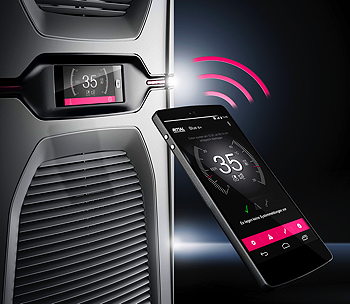- Home » News » Technology News
‘Quantum leap’ in enclosure cooling cuts energy use by 75%

The German enclosures giant Rittal has developed a new way of cooling enclosures that it describes a “quantum leap”. Initial results from a pilot installation at Audi are showing energy savings of 75% compared to Rittal’s previous TopTherm Blue e cooling systems. The new Blue e+ system is also claimed to deliver benefits in terms of flexibility, safety and ease of use.
The new system – the result of four years of development – made its debut at this month’s Hannover Fair. It uses a patented hybrid process that combines compressor cooling with passive cooling using heat pipes. The compressor is used only when the passive cooling is insufficient.
The control strategy is optimised to achieve high energy efficiencies in part-load operation. Rittal claims that the Blue e+ is six times more efficient than conventional cooling at a 15% load, when operating in the pure heat-pipe mode. At a part-load of 65%, both systems operate together, four times more efficiently than a conventional cooling system.
The efficiency of the compressor is said to be particularly high, with DC motors being used both for the fans and for the compressor. Inverter technology is used to control the compressor and fan speeds via a voltage control system, to ensure that the cooling output is always the precise amount needed at the time.
In the pilot installation that has been running at Audi’s Ingolstadt plant since January, the new system is being compared to production control enclosures using previous Rittal cooling systems. “Compared with the current TopTherm Blue e systems and under the same conditions, we have so far achieved energy savings of 75% with the Blue e+”, reports Andreas Korn, from Audi’s automation technology planning division. “Rittal is definitively setting new standards for energy efficiency in enclosure climate control.” The tests are due to continue for a year.
The precise cooling control is also claimed to reduce thermal stresses on components inside an enclosure, eliminating the temperature fluctuations associated with conventional two-point control systems. As well as increasing the service life of the components and compressor, this should also lead to higher process reliability.
In another field trial, at the German machine-builder Kapp Werkzeugmaschinen, temperature fluctuations have been cut by 95%, compared to conventionally regulated cooling systems. Since January, a wall-mounted Blue e+ cooling system has been assessed against an existing wall-mounted two-point controlled cooling system using identical enclosures.
Measurements of the temperatures inside the older enclosure deviated by 5K from the set value, while with the new cooling system the deviation was only 0.2K from the set value over the same period. “This result really surprised and impressed me,” says Alfred Tenner, Kapp’s head of measurement and control. “Given the temperature accuracy of Rittal’s new Blue e+ cooling units, we can significantly reduce the thermal stress on our control systems and automatically increase the life of our systems.”

The new cooling systems will be available in ratings up to 6kW and can be used at temperatures from –30°C to +60°C. They have a patented multi-voltage operating capability, allowing them to run on input voltages from 110V (single phase) to 480V (three-phase), at grid frequencies of 50 or 60Hz. This will allow the same cooling system to be used almost anywhere in the world – an attraction for exporting OEMs which will result in a reduction in the number of device variants, as well as simplifying spare parts logistics.
A multilingual TFT display on the front of the cooling system provides relevant information at a glance in plain-text messages. Standardised communication interfaces simplify integration with control systems. Support for protocols such as CANbus or Modbus TCP allows real-time data transfer via a CAN or Ethernet interface. A near-field-communication (NFC) interface allows multiple cooling systems to be parameterised easily using an NFC-enabled mobile device such as a smartphone.
The potential savings in energy use and carbon emissions from the new generation of cooling systems are substantial. Rittal estimates that in Europe alone, there are around two million enclosure climate control systems in use, with a total connected load of around 2TW (assuming an average of 1kW per enclosure). These systems are responsible for about four million tonnes of CO2 emission per year.





